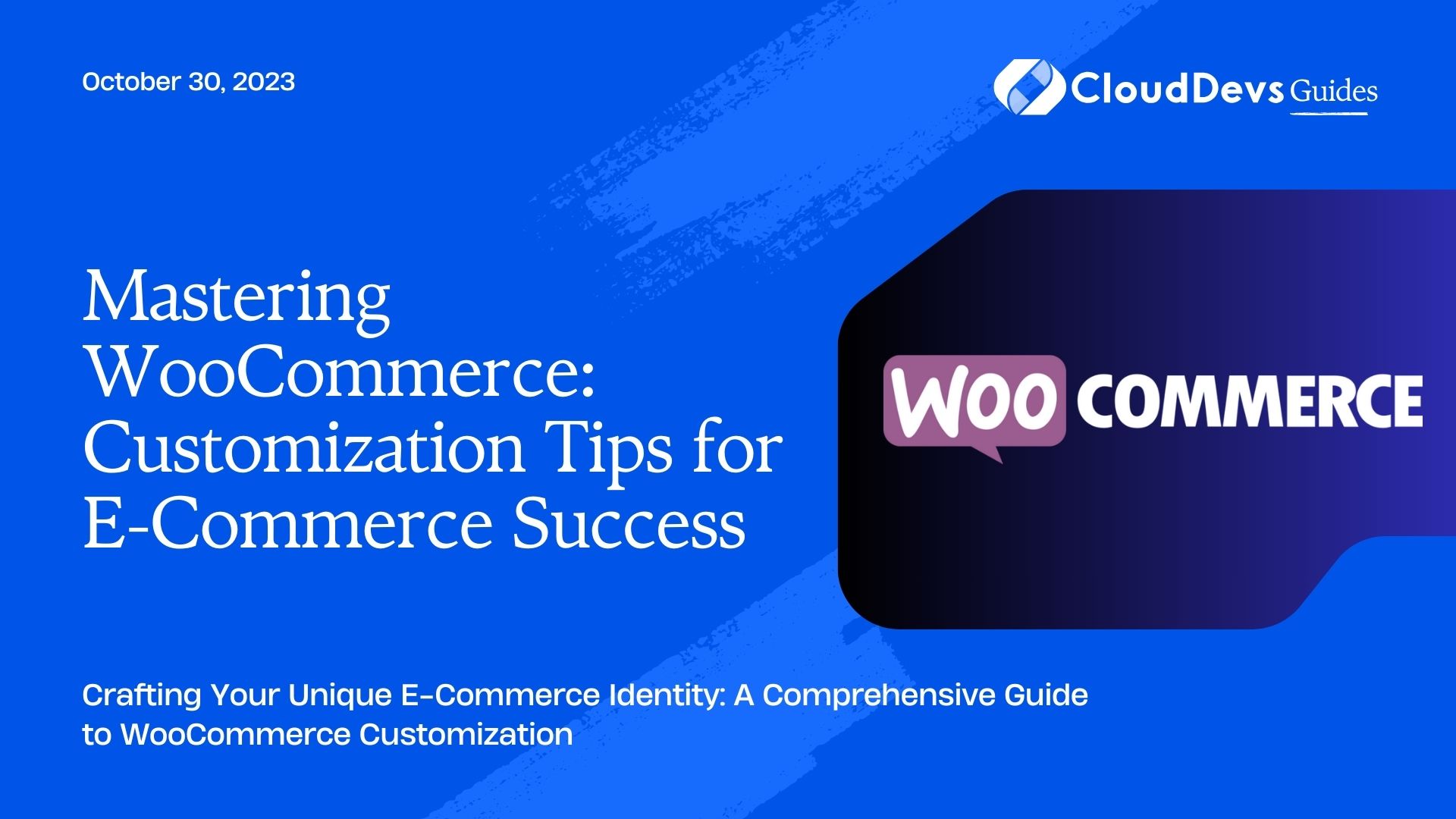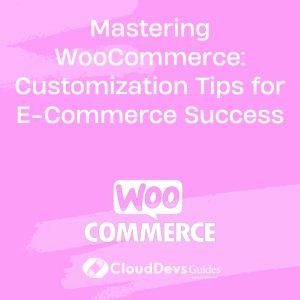Mastering WooCommerce: Customization Tips for E-Commerce Success
WooCommerce, the popular WordPress plugin, has become the go-to solution for anyone looking to set up an online store quickly and efficiently. While WooCommerce offers a plethora of features out of the box, there may come a time when you want to take your online store to the next level by customizing it to better suit your brand and business needs. In this blog post, we’ll explore the world of WooCommerce customization and help you get started on the right path.
1. Why Customize WooCommerce?
Before we dive into the “how” of WooCommerce customization, let’s briefly touch upon the “why.” There are several compelling reasons to customize your WooCommerce store:
1.1. Branding and Unique Identity
Customization allows you to craft a unique online presence that aligns perfectly with your brand’s identity. Whether it’s altering the color scheme, typography, or layout, you have the freedom to create a store that resonates with your target audience.
1.2. Enhanced User Experience
Tailoring your WooCommerce store to your specific needs can significantly improve the user experience. By optimizing the design and functionality, you can make it easier for customers to navigate, find products, and complete purchases.
1.3. Competitive Advantage
Customization can give you a competitive edge in the crowded e-commerce space. A distinctive and well-tailored online store can attract and retain customers more effectively than a generic one.
1.4. Integration with Third-Party Tools
Customization allows you to integrate your WooCommerce store with various third-party tools and services, such as payment gateways, marketing automation, and analytics platforms.
1.5. Address Unique Business Requirements
Every business is unique, and customization enables you to address specific business requirements that may not be met by the default WooCommerce features.
Now that we understand the “why” let’s delve into the “how” of WooCommerce customization.
2. How to Begin Customizing WooCommerce
WooCommerce offers multiple ways to customize your online store, ranging from simple visual changes to more complex alterations of functionality. Here are some key areas to get you started:
2.1. Theme Customization
Your WooCommerce store’s theme is the foundation of its visual identity. You can customize your theme in various ways:
1. Theme Selection
Choose a WooCommerce-compatible theme that aligns with your brand and design preferences. There are numerous free and premium themes available, such as Storefront, Astra, and Flatsome.
2. CSS Styling
Customize the look of your store by modifying CSS styles. You can adjust colors, fonts, spacing, and more to match your branding.
3. Child Themes
Consider using child themes to make changes to your theme without affecting the original theme’s code. This ensures that your customizations remain intact even when the theme receives updates.
2.2. Plugin Integration
WooCommerce provides a vast ecosystem of plugins that can enhance your store’s functionality. Here are some examples:
1. Payment Gateways
Integrate additional payment gateways to provide customers with more options. For instance, you can add PayPal, Stripe, or Authorize.Net, depending on your target audience.
2. Shipping Options
Customize shipping methods to accommodate your business’s specific needs. You can offer flat-rate shipping, free shipping, or even set up custom shipping rules based on location or order total.
3. SEO Optimization
Install SEO plugins like Yoast SEO to improve your store’s visibility in search engines. These plugins help you optimize product pages, meta tags, and other SEO elements.
2.3. Product Customization
Your products are at the heart of your e-commerce business. Customize how they are displayed and sold:
1. Product Pages
Tailor the layout and content of your product pages to highlight key product details and encourage conversions. You can display additional images, videos, and customer reviews to enhance product descriptions.
2. Product Variations
If you sell products with various options (e.g., size, color), customize product variations to streamline the shopping experience. Make sure customers can easily select their preferred options.
2.4. Checkout and Cart Customization
Optimize the checkout process to reduce cart abandonment rates and increase conversions:
1. Cart Page
Customize the cart page to display product summaries, quantity adjustments, and promotional messages. Offer a seamless and straightforward checkout experience.
2. Checkout Fields
Remove unnecessary checkout fields and collect only essential information. This reduces friction during the checkout process and encourages customers to complete their purchases.
2.5. Custom Coding
For advanced customization needs, you may need to dive into custom coding. WooCommerce allows developers to create custom themes, plugins, and functionality tailored to your precise requirements. Here are some examples of custom coding tasks:
1. Custom Plugins
Develop custom plugins to add unique features or integrations to your WooCommerce store. This could include a custom loyalty program, product configurator, or advanced reporting system.
2. Hooks and Filters
Use hooks and filters provided by WooCommerce to modify various aspects of your store without altering the core code. This allows for highly granular customizations.
3. Custom Templates
Create custom templates for specific pages or elements in your store, such as the product page or checkout process. Custom templates give you full control over the HTML structure and design.
3. Real-World Examples of WooCommerce Customization
To illustrate the power of WooCommerce customization, here are some real-world examples:
3.1. Subscription Box Store
Imagine you want to start a subscription box service. You can customize WooCommerce to handle recurring payments, manage subscription renewals, and offer personalized subscription options. Plugins like WooCommerce Subscriptions can help you achieve this.
3.2. Artisanal Jewelry Shop
Suppose you run an artisanal jewelry shop. By customizing your theme and product pages, you can showcase the uniqueness of each piece, allowing customers to zoom in on intricate details. Additionally, you can offer a “Build Your Own Jewelry” feature, enabling customers to mix and match components to create their custom pieces.
3.3. Local Grocery Delivery
If you operate a local grocery delivery service, WooCommerce customization can help you set up customized delivery time slots based on ZIP codes and offer flexible payment options. You can also integrate with third-party delivery services for seamless order fulfillment.
Conclusion
Customizing WooCommerce is an exciting journey that allows you to create an online store that truly represents your brand and meets your business needs. Whether you’re making simple visual changes or diving into custom coding, WooCommerce offers the flexibility and tools you need to make your e-commerce dreams a reality.
As you embark on your WooCommerce customization journey, remember to start with a clear plan, test your changes thoroughly, and consider seeking the expertise of a developer or designer if needed. With the right approach, your customized WooCommerce store can set you apart in the competitive world of e-commerce and lead to increased sales and customer satisfaction. So, where will you begin your WooCommerce customization adventure? The possibilities are endless!
Table of Contents







